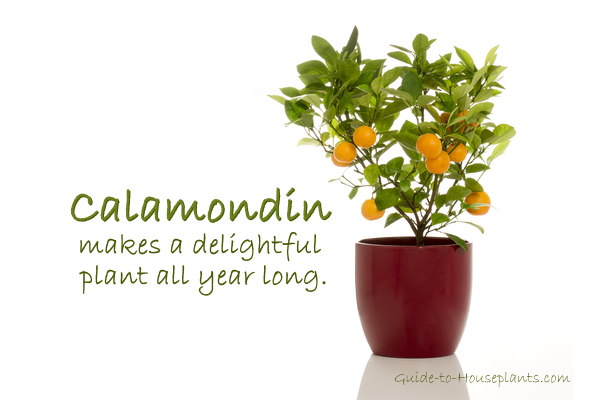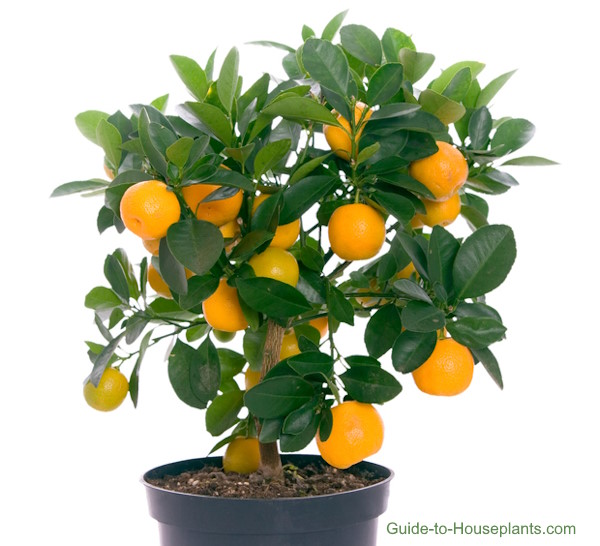Care for Calamondin Orange – Dwarf Citrus Tree
Botanical Name: Citrus x citrofortunella mitis hybrid
Calamondin orange tree is one of the best indoor fruit trees. Buy plants from a reputable grower that are grown from cuttings. Citrus plants that are grown from seed aren’t reliable to bear much fruit.
This perennial shrub is actually a cross between a kumquat and a tangerine. Woody stems of this dwarf citrus tree are densely covered with oval, glossy green leaves that have a citrusy aroma.

You can expect an abundance of flowers and fruits, beginning in its second year. Fragrant, white, star-shaped flowers will appear at the tips of branches in summer, followed by 1-2 in (2.5-5 cm) fruits.
Ripening slowly, the fruits change from deep green to bright orange. You’ll usually see flowers and fruits on the tree at the same time, making calamondin tree a fresh, colorful accent for a sunny room.
There is no hurry to pick calamondin oranges. They’re long-lasting, so you can enjoy them for months on the tree. These oranges are tart, to say the least. Sample one for sourness before using any in cooking. You can use them in place of lemons in a recipe. I’ve heard they do make delicious marmalade.
Prune your plant back when new growth starts in spring to prevent it from getting leggy. Pruning back long branches in spring will encourage new branches to grow from just below the cut. Cut at an angle just after a leaf node (where a leaf attaches to a stem).
Repot young plants every couple years. Plants won’t bloom if they are overpotted, so keep them in small containers. Use a pot that’s about 6 in (15 cm) in diameter until plants are 3 or 4 years old, then move up to an 8 in (20 cm) container. Always use a pot with a drainage hole to prevent root rot.
Pollinate your plant. Calamondin orange trees that are grown indoors will need to be hand-pollinated to trigger fruit production. Relax, it’s easy to do. Use a small, dry paintbrush to dab each flower. Wiggle the brush around the center of each flower, moving from flower to flower. This carries the pollen from male to female flowers, just like bees do it.
Calamondin Growing Tips

Origin: China
Height: 3-4 ft (90 cm – 1.2 m)
Light: Give your orange tree as much direct sunlight as you can year-round (at least 4 hours of direct sunlight each day). Turn the plant a quarter turn every week because it will tend to grow toward the light source. You can move it outdoors during the warm months to give it a boost.
Water: Water thoroughly, allowing the surface of the soil to dry between waterings. Soggy soil will lead to root rot, which is a sure way to kill a citrus tree.
Humidity: Moderate (around 40-50% relative humidity). Dry air may cause the flowers to drop off. Put the container on a tray of wet pebbles and mist the foliage to increase humidity. If your home is really dry, use a cool-mist room humidifier.
Temperature: Average room temperatures 65-75°F/18-24°C are ideal year-round. This citrus tree will tolerate a minimum of 50°F/10°C in winter.
Soil: Use a soil-less, peat moss-based potting mix with added perlite and/or vermiculite for fast drainage. Citrus trees don’t like their roots in soggy soil.
Fertilizer: I highly recommend an organic fruit tree fertilizer. It contains all the nutrients citrus trees need for healthy root growth and promotes flowers and fruits.
Propagation: Take stem cuttings in early summer. With a sharp knife or razor blade, take 4 in (10 cm) stem tip cuttings with at least 2-3 leaf nodes without flowers or fruit. Dip cut end in hormone rooting powder before inserting in moist potting mix, then enclose in a plastic bag to maintain humidity. Stem cuttings will root in about 6-8 weeks.




